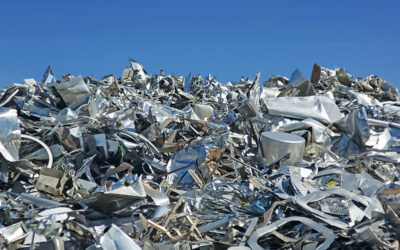By Julie McNabb, Writer/Editor ASSET 2.0
There’s Gold In Them There E-waste… and so much more!
How big is the e-waste problem, really? Besides the environmental issue, what about the valuable metals and other materials that could be recovered and recycled? They have monetary value, right? So how much money are we throwing away as e-waste? A pilot study in Minnesota wanted to find out, and it’s a mind boggler. Plus, learn about some of the innovative products now being made from recycled scrap. You might be surprised.
If there is one topic that IR professionals can’t get enough of – is keeping our organizations’ e-waste out of landfills. That’s why ASSET 2.0 brings you the very latest in eco-friendly e-waste disposition. Most recently in VOL.1, we focused on how companies were deploying new technologies and programs primarily to harvest valuable metals from trashed electronics.
But what about e-waste from consumers and smaller businesses that don’t have an effective recycling program? Despite our best efforts on behalf of our respective companies, the problem in some states appears to be getting bigger not smaller.
This article picks up the e-waste story from a few months ago. First, we will take a look at how one state studied its e-waste problem in-depth. Then, we’ll go beyond simply mining precious metals for recycling, but making new (and amazing!) products from electronic scrap.
Minnesota — the land of 10 000 lakes and… 266 million pounds of e-waste
per year
In 2007, Minnesota passed an electronics waste law – mostly taking aim at junked televisions, computers, and fax machines. It required manufacturers to buy recycling credits based on the weight of their products. The good news is that the state has diverted more than 400 million pounds of electronics from landfills and incinerators. And the not-so-good news?
As devices became smaller and lightweight, more people would simply toss them into forgotten drawers or into the trash – thus decreasing the weight being recycled each year. The outcome was all too predictable – more e-waste is being landfilled or incinerated. Not only was it an environmental hazard, but lost revenue potential, primarily from mining precious metals.
Maria Jensen, an employee of Repowered, a non-profit electronics recycling company based in St. Paul, got curious: How much money is the state losing by not harvesting recyclable metals? Her question ultimately led to a pilot study team comprised of Repowered, the Iron Range Partnership for Sustainability and Macalester College. Their study, “The Economic Potential of E-Waste Recycling in Minnesota” found that there is $2.8 billion worth of metals not being recovered in Minnesota’s electronic waste stream every year.
Even with 266 million pounds of e-waste available for recycling in the state annually, only 23.7% of it gets captured according to their research.
Using peer-reviewed research, market prices of metals, and local data on e-waste, the researchers discovered some eye-opening data: If 100% of the 266 million pounds of e-waste generated in Minnesota each year were captured for recycling or refurbishment, the effort would generate:
- 1,738 direct jobs
- 78 million pounds of valuable metals
- Enough copper for 155,000 electric vehicles
- Enough silver to produce 441,000 solar panel
- $2.8 billion in annual revenue.
And that’s just one state. Had this study been conducted in your state, what would it reveal? Food for thought. But beyond precious metals from e-waste, what other products could be made? For that, ASSET 2.0 looked far and wide for answers.
Products made from e-waste…really?
E-waste metals and materials are being recycled into home appliances, refrigerators, office furniture, playground equipment, lawn chairs, car parts, containers and anything made from recycled plastics. Many of the aforementioned may be familiar to you, but ASSET 2.0 went on a search for the more unusual products made from e-waste that are making headlines.
Out of Africa…not the movie
Nairobi cousins inspired by Einstein.
In Kenya, cousins Moses Kiuna, 29, and David Gathu, 30, like to scour junkyards for e-waste to build their inventions. These self-made innovators work out of a cramped lab next to their grandmother’s house where a portrait of Einstein hangs on the wall to spark their inspiration.
Since high school, the pair have been digging through dumping grounds around Nairobi – treasure hunting for discarded electronic gadgets and debris to create or repurpose more than a dozen inventions.
For example, when COVID-19 struck, they built a device to sterilize banknotes using infrared technology. That was followed by a green-energy generator converting oxygen into electricity to counter climate change.
And then they saw an urgent need for disabled people who couldn’t afford prosthetics. Gathu stated, “We saw people living with disabilities go through a lot of struggles and so we desired to make them (prosthetics)…We studied neurophysiology by reading books and sitting with doctors to explain concepts to us.”
Kiuna said their first prosthetic arm was custom-made for a neighbor after an industrial accident. He stated, “It helped him operate around the house on his own”.
But their latest invention is making news — a bio-robotic prosthetic.
The device utilizes a headset receiver that converts brain signals into an electric current which is then
sent to a transmitter that wirelessly relays commands to the limb.
All from scavenged electronic scrap – along with the lack of a formal education and no financial support.
The pair hope to turn their prosthetic arm and other innovations into a thriving business.
“We have many other ideas that we can make viable commercially, but we lack finances and support,” Gathu said. Hopefully, that will change in the near future.
Tanzania builds 3D printers from…
Meanwhile, in neighboring Tanzania at a mini-fabrication lab called Buni Hub, they are building 3D printers from e-waste. “It took us eight weeks to build our first 3D printer,” explains co-manager Paul Mandele. The team used steel rods from broken printers, stepper motors from old electronics and power cables from discarded computers.
The business plan was to use the newly created 3D printers to make visual teaching aids. However, as Mandele explains, a lot of Buni Hub’s work is now printing parts for more 3D printers. “We have tested other use cases,” Mandele adds. “Recently, we piloted the printers to make prosthetics and other tools that can be used in the medical field.”
Keeping Nigeria out of the dark
In West Africa, Nigeria suffers from severe grid problems, resulting in numerous black outs every year. For small businesses, this is serious – as it cuts into productive working hours and days. The other option is to use expensive generators that few can afford. That’s when entrepreneur Dozie Igweilo devised a two-fold solution to keep the country out of darkness but that also reduces waste and emissions at the same time.
His company, QuadLoop, recycles parts from electrical scrap to produce low-cost solar lamps. They start by using scrapped lithium batteries from old laptops and placed them in the lanterns. E-waste wires, screws and screens are also recycled for the casing of the solar units. The price tag for each unit is 32 euros and they are mainly used by small businesses needing to stay operational during power outages.
Because the lamps are mostly made with used
parts, they only come with a one-year warranty,
but also with the added benefit of getting their batteries replaced.
Computerized jewelry?
UK’s Royal mint boasts an 1100-hundred-year history minting currency and other precious metal products literally fit for a king. In 2022, they launched their 886 Collection, the world’s first luxury jewelry brand to use 100% recovered gold sourced from discarded electronic waste. The Royal Mint has partnered with the Canadian clean technology firm Excir, to extract pure gold from discarded laptops and mobile phones, using their revolutionary technology.
The patented chemical formula recovers over 99% of the gold contained within used electronics, supporting a UK-based circular economy and providing a fresh source
of high-quality precious metal.
And for that high-tech glam? US-based Etsy is offering custom-made earrings made from circuit boards. Really.
The Green Ant of Spain
La Hormiga Verde is a Spanish company that recovers and resells components and raw materials from trashed electronic devices. They also deconstruct plastic and metal bits and pieces that are unsellable, eventually making them into new products like furniture and flowerpots.
La Hormiga Verde, or the ‘the green ant” perfectly describes the company’s owner, Ignacio Garci as he gathers and stores all kinds of e-waste. “I lost my job in 2018 and had to reinvent myself,” says Garcia, 50, an industrial engineer who spent 15 years in the biomass industry. “Looking at my mobile, I realized it was packed with recyclable materials. I saw a business opportunity.”
Of its 34 workers, 32 have some kind of disability. “I conceived the company as a tool to help other people who had lost their job, as I did,” Garcia says.
“There’s gold in them there e-waste!”
Yes there is – and so much more as Minnesota found out. What about your state? As more and more e-waste enters the circular economy, investment recovery will become an essential economic and environmental link.
Sources:
www.kare11.com, “Pilot Study Minnesota’s E-waste worth 28 billion each year,” May 2, 2023
www.redlakenationnews.com, “New Pilot Study Demonstrates Huge Potential in MN for E-waste Recycling,” Mar. 14, 2023
www.lifetechnology.com, “Kenyan Innovators Turn E-waste to Bio-robotic Prosthetic,” Mar. 8, 2023
www.medicalxpress.com, “Kenyan E-waste Bio-robotic Prosthetic,” Mar. 8, 2023
www.ecopolitic.com, “In Spain the Company Sells Components from Old Appliances and Makes Furniture from Garbage,” Apr. 29, 2022
www.sahanjournal.com, “Electronics Recycling Waste Minnesota Repowered,” Jan. 18, 2023
www.redlakenationnews.com, “New Pilot Study Demonstrates Huge Potential in MN for E-waste Recycling,” Mar. 14, 2023
www.ecoatm.com, “What Can Be Made from Recycled Electronics”
www.euronews.com, “Solar Lamps Made from E-waste are One Solution to Nigeria’s Power Outages,” Oct. 24, 2022
www.royalmint.com, “About Us”
www.circularonline.co.uk, “The Royal Mint Launches Jewelry Collection Made from Gold Recovered from Electronic Waste”, May 23, 2022
www.bloomberg.com, “Electronic Recycling Turns Old Phones TVs Into Furniture,” Apr. 28, 2022



